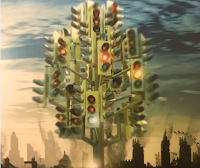This academic study of costume and production design in Doctor Who has been a stimulating read, full of connections and insights that are new to me.
The author is professor and director of media and visual culture studies at the University of Redland in the US, and his 2003 book, Reading Between Designs: Visual Imagery and the Generation of Meaning in The Avengers, The Prisoner and Doctor Who, continues to be of great use in the stuff I write for the Doctor Who Figurine Collection, not least because Piers and co-author Simon Barker spoke to many designers who have since died, such as Daphne Dare who oversaw almost all the costumes for the first two years of the series. In turn, it's a bit of a thrill to see some of my own work cited in this new volume, almost like some kind of authority.
The book is in three parts. Part One is a breezy history of design in Doctor Who from 1963 to 2020, placing things in context of other TV and film, and trends in design more widely. In Part Two, he traces different ways in which we might judge and evaluate design - basically, how do we tell the good stuff? In Part Three he explores 13 particular instances of design in more depth.
As he says at the start, "In almost every episode Doctor Who [there have been 862 to date] relies heavily on both visual and sound design to create an immediate and powerfully evocative effect" (p. 15), so it's all the more impressive how much he packs in. He's on to something when he says in the introduction that Doctor Who often juxtaposes its relatable, regular characters with the strange places they visit - even when the TARDIS visits the present-day, there's something weirdly, eerily wrong going on. I think there's something else going on, too: the effort of each Doctor Who story to be visually distinct, juxtaposing itself against its immediate predecessor and all those that have gone before. Piers charts some of this, the ways in which, through design, the series converses with itself.
He's right that, all too often in fan criticism, "writing [and performance] has long been explicitly privileged over the visual", with elements of design getting "none of the nuanced evaluation typically lavished on writing and characterisation (p. 119). He uses the 1982 story Kinda as an example of a story highly praised despite serious shortcomings in design: an alien forest realised with pot plants in an overlit TV studio, and the laughable giant snake at the end. As he says, such fan criticism,
"turns Doctor Who's alleged visual crudeness into a mark of distinction: the discerning fan recognises such matters as design as a superficial consideration" (p. 120).
I think there's a corollary to that: Kill the Moon (2014) is an example of a story with very good, realistic design, but it's at odds with a rather whimsical, even silly, plot involving a giant egg. I find myself wondering if critics of the story would not have minded so much had the design been less credible.
Given my own current interest in the set design of 1960s episodes, I'm particularly struck by what Piers can reveal here. He starts with the 1961 book written by the BBC's Head of Design, Richard Levin, which sounds enormously like my sort of thing:
"A glance at Television by Design reveals a very different BBC from the image which has been cultivated abroad and to an extent also domestically over the last fifty years - the Masterpiece Theatre myth of a BBC whose output is built around period pieces and especially 'bonnet dramas' ... the visual content of his book tells a different story: it overwhelmingly presents a BBC steeped in modernism." (pp. 21-2).
Levin's department, and therefore the futuristic bits of Doctor Who, were, "permeated with the design sensibilities of Constructivism, Neoplasticism and the International Style in architecture" (p. 25). Piers is good not only on such context and influence, but also the practical side of design, especially on the TARDIS interior. The original set, designed by Peter Brachacki in 1963, is the first of Piers' thirteen designs deserving of special attention:
"Brachacki's TARDIS control room is a specifically telegenic set - which is to say, it is friendly to the relatively low-definition, monochrome screen image of the 1960s and also to the talk-heavy television fiction which was to remain standard until the later 1980s. In many ways, the nearest cognates to the original TARDIS set in BBC programming were the austere, light-filled spaces which Natasha Kroll's Studio Design Unit made for current affairs and talk shows in the years around 1960. In these often exquisitely simple sets, minimal decor and semi-abstract forms focused attention on the presenters and interlocutors ... The control console's hexagonal design, with its rising and falling central column, provided both visual interest and an anchor for dialogue, creating the basis for shots in which three or more people could be groups naturally with their facial expressions clearly visible on camera."(p. 148)
From this, Piers then details how developments in television technology - higher resolution cameras, colour, single-camera shooting - ironically served to reduce the effectiveness of this so achingly modern and telegenic set. It had never occurred to me before to consider the practical reasons why the TARDIS interior needed to change, beyond set pieces having worn a bit thin.
This is just one example. There are plenty more insights, such as the way Barry Newbery designed for stories set in Earth history, "replete with visual detail which intimately evokes the day-to-day life of is protagonists" (p. 23), in contrast to the brutalist, bare visions of the future that Ray Cusick tended to base on a smallish set of recurring geometric shapes.
There are some very minor errors: he includes the Quarks in a list of monsters introduced under producer Innes Lloyd (who had left the programme before The Dominators was commissioned); he includes Donna Noble in a list of characters he says are "working class". But these are quibbles, nit-picking, and I'm sure the result of efforts to pack in detail and cover so much ground.
Personally (and selfishly, as it would be useful for my own work), I'd have liked more direct quotation from the designers themselves. There are also things I don't agree with. Piers has firm opinions on what does and doesn't work: the iconic Time Lord collars are, he says, "ostentatious and campy" (p. 173); the Eighth Doctor's costume in the 1996 television movie, "ill-fitting and ugly"; the Twelfth Doctor's era has, "the tinniest arrangement of the Doctor Who theme" (p. 209). I am actually amazed by the pages devoted to his thesis that the Sixth Doctor's multicoloured outfit,
"does not represent the worst of Doctor Who's creative stagnation in the mid-eighties. That distinction belongs to the costume worn by Baker's successor, Sylvester McCoy" (p. 182).
He's insightful about the thinking behind and effect of the 13th Doctor's costume - something I've written about in some depth - though he cites a criticism that it might represent a "feminine absorption with style" (p. 215). This (which isn't Piers' view, just one he's quoting) really doesn't hold water - as he shows, having just gone into detail about how much the male Doctors are defined by their outfits. On this, I'm very much with Sophia McDougall re. capes and weddings dresses.
But that's rather the point - I want to argue back and I think Piers is inviting response in what he himself calls, "a first sortie into an immense territory" (p. 221). It's a book to grapple with, interrogate and battle. It has got me thinking anew about a whole load of aspects of Doctor Who. I am sure it will find its way into things I write to come...










































